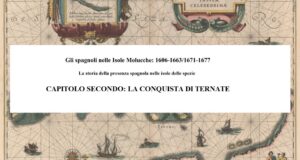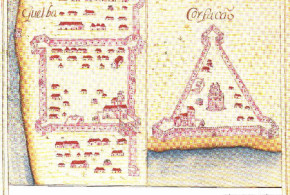Written by Marco Ramerini. English text revision by Dietrich Köster.
The Portuguese town of Chaul lies about 350 kilometers north of Goa and 60 kilometers south of Bombay (Mumbai) at the mouth of the Kundalika river near the village of Revdanda. Chaul was located on the low northern bank, opposed to a promontory on the south bank, which is called “Morro de Chaul.
Chaul was from 1521 under the Portuguese. In the same year they built the first fort. In October 1531 the Portuguese erected a massive square stone fortress at Chaul, which contained a church and dwelling-houses for 120 men. The fortress was named “Santa Maria do Castelo”. Around this castle the Portuguese town developed, but by a treaty of the year 1558 the town‘s fortification could no longer be upheld.
In November 1570 Chaul was attacked by Nizam Shah. The siege lasted for months. The town was exposed to great distress. But at the end, in July 1571, the siege was raised and a treaty was signed. After the siege the town was rebuilt and town walls with several bastions were built around it.
In April 1592 the Moors began a new siege of Chaul, but after a hard battle the Portuguese succeeded in repelling the assault. In 1594 the Portuguese conquered the adjoining fortress of the “Morro de Chaul”. Owing to the repeated attacks by the Moors against Chaul, new works of defense were carried out in 1613.
The Portuguese power declined and Chaul slowly lost its importance. In March 1739 Chaul and the fortress of “Morro de Chaul” were besieged by the Angria, but after some months, in October, the Angria raised the siege. On 18 September 1740 Chaul was finally ceded by treaty to the Mahrattas.
The ruins of Chaul are near the town of Revdanda south of Bombay (Mumbai). There are still visible of Portuguese Chaul today: the ruins of the town walls with its powerful ramparts, the ruins of the Igreja Matriz, the church and the convent of the Augustinians, the Franciscans’ church, the Misericórdia, the “Porta do Mar”. Of the adjoining fortress of the Morro de Chaul the remains of its walls are still to be seen. In Korlai, a few kilometers from Chaul, there is a community of people (900), who still speaks a Creole form of Portuguese down to the present day. They are monolingual.
BIBLIOGRAPHY:
– Cunha, G. da “Notes on the history and antiquities of Chaul and Bassein” 278 pp. Map & ills. 1993 (1876), Bombay, India.
– Fernandes, José Manuel “Chaul um percurso urbano e fotográfico ” In: “Oceanos” n°19-20, Sep/Dec. 1994 pp. 268-271
– Gaspar Rodrigues, Vitor Luis “A organização militar da Província do Norte durante o séc. XVI e princípios do séc. XVII” In: Mare Liberum, Revista de História dos Mares N° 9, ” VII Seminário internacional de História Indo-Portuguesa, Goa 1994″, pp. 247-265, 1995, Lisbon, Portugal.
– Goertz, R. O. W. “Attack and defense techniques in the siege of Chaul, 1570-1571” In: Various Authors “II Seminário Internacional de História Indo–Portuguesa” 265-287 pp. IICT & CEHCA 1985 Lisboa, Portugal.
– Jackson, K. D. “Ruínas de Império: a cidade-fortaleza de Chaul” In: “6° Congresso da Associaçao Internacional de Lusitanistas” 8-13 Aug. 1999, Rio de Janeiro, Brazil.
– Leão, M. C. “A Província do Norte do Estado da Índia” 223 pp. several maps and illustrations, Instituto Cultural de Macau, 1996, Macau.
– Mitterwallner, G. von “Chaul: Eine unerforschte Stadt an der Westküste Indiens (Wehr-, Sakral- und Profanarchitektur).” 238 pp. ills and 2 maps 1964 Berlin, Germany.
– Oliveira e Costa, João Paulo “Simão de Andrade, fidalgo da Índia e capitão de Chaul” In: Mare Liberum, Revista de História dos Mares N° 9, ” VII Seminário internacional de História Indo-Portuguesa, Goa 1994″, pp. 99-111, 1995, Lisbon, Portugal.
– Rossa, W. “Indo-Portuguese cities” 117 pp. illust. Comissão Nacional para as Comemorações dos Descobrimentos Portugueses 1997, Lisbon, Portugal. Very interesting descriptions of the Portuguese towns of Goa, Chaul, Baçaim, Damão, Diu and Cochin.
 Colonial Voyage The website dedicated to the Colonial History
Colonial Voyage The website dedicated to the Colonial History



































































